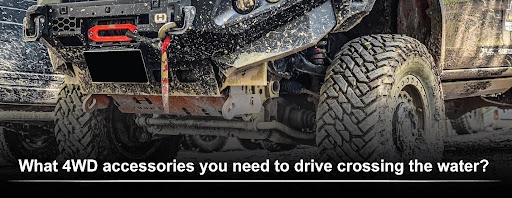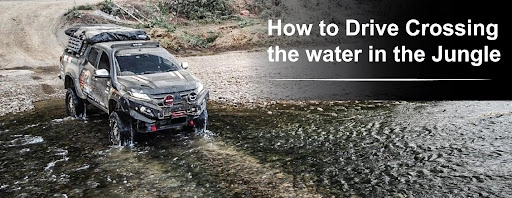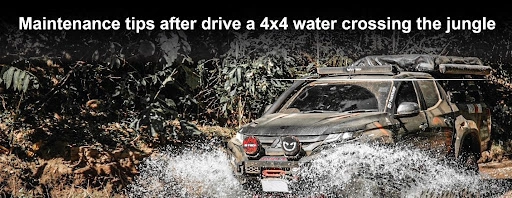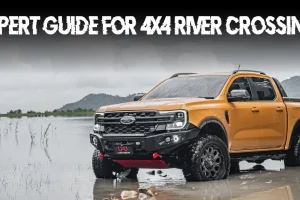NEWS & ACTIVITY
Ultimate Guide to Drive a 4×4 Water Crossing in The Jungle
Driving a 4×4 vehicle through water crossings can be an exhilarating and challenging experience for off-road enthusiasts. However, it’s essential to approach water crossings with caution and follow proper techniques to ensure both your safety and the well-being of your 4WD vehicle. But first, we need to know the difference between driving water crossing in the jungle and on the beach and see which terrain are you looking for:
Water Crossing in the Jungle VS on the Beach
Driving a 4×4 through water crossings in the jungle and on the beach presents unique challenges. In the jungle, obstacles like fallen trees and uneven terrain require careful navigation. The murky water and limited visibility make depth and current assessment more difficult. Traction is crucial on muddy surfaces with hidden hazards. On the beach, soft sand and exposure to saltwater affect traction and require proper tire pressure adjustments. Monitoring tides and coastal conditions is essential. Luckily, Hamer4x4 has very helpful articles on How to drive on the sand and driving on the beach for someone who needs to dig deeper techniques to get out of the stuck.
What 4WD accessories do you need to drive crossing the water?
When it comes to driving through water crossings in the jungle off-road, there are several 4WD accessories that can help enhance your vehicle’s capability and safety. Here are some accessories that can aid in navigating water crossings in the jungle:
-
Snorkel:
A snorkel is a raised air intake system that allows your vehicle to breathe cleaner air when crossing deep water. It raises the air intake above the roofline, reducing the risk of water entering the engine and causing damage.
-
Differential Breathers:
Differential breathers are extensions that elevate the breathers on differentials, transfer case, and transmission. They prevent water from entering these components during water crossings, reducing the risk of water contamination and damage.
-
Skid Plates:
Skid plates are protective plates installed underneath your vehicle’s critical components, such as the engine, transmission, and fuel tank. They shield these vulnerable parts from rocks, debris, and potential impacts during water crossings. You can also add the under-protection plates along with the skid plates to protect the whole vehicle from obstacles.
-
Recovery Points:
Recovery points, typically installed on the front and rear of your vehicle, provide secure attachment points for recovery equipment. They allow for safe and effective vehicle recovery in case you get stuck or need assistance during a water crossing.
-
All-Terrain Tires:
Equipping your vehicle with all-terrain tires that have a robust tread pattern and good traction is crucial for navigating through muddy and slippery terrain, including water crossings. These tires provide improved grip and traction, enhancing your vehicle’s ability to maintain control in challenging conditions.
*Hamer4x4 Pro Tips:
Don’t forget to slightly deflate your tires to increase the surface area and improve traction on wet surfaces.
-
Winch:
A winch is a mechanical device that uses a cable or rope to pull your vehicle out of difficult situations. It can be invaluable if you get stuck in deep water or encounter challenging terrain during a water crossing in the jungle.
-
Waterproofing and Sealing:
Taking steps to waterproof and seal critical electrical components, such as connectors, wiring, and ignition systems, can prevent water damage and ensure the reliability of your vehicle during water crossings.
How to Drive 4×4 Crossing the Water in the Jungle
So now, we will focus only on Driving a 4×4 vehicle through water crossings in the jungle. It requires careful navigation and an understanding of the unique challenges presented by this environment. Here’s a step-by-step guide on how to tackle water crossings in the jungle when going off-road:
-
Assess the Water Crossing:
Before proceeding, evaluate the depth, flow, and stability of the water crossing. Look for submerged obstacles, such as rocks or fallen branches, that could pose a risk.
-
Engage 4WD and Low Range:
Shift your vehicle into 4WD mode and engage low range for better traction and control. This maximizes torque and minimizes wheel spin.
-
Maintain a Steady Speed:
Maintain a consistent and moderate speed while crossing the water. This helps create a bow wave in front of the vehicle, preventing water from entering the engine bay.
-
Drive in the Tracks:
If there are existing tire tracks from previous vehicles, follow them as they indicate a safer path with the firmer ground. Avoid veering off into unknown or potentially softer terrain.
-
Control Your Momentum:
Avoid sudden acceleration, deceleration, or excessive speed, as these can lead to loss of control. Maintain a steady and controlled pace throughout the water crossing.
-
Monitor Water Depth and Bow Wave:
Keep an eye on the water depth gauge (if available) and observe the bow wave created by your vehicle. If the water level rises too close to the hood or if the bow wave diminishes, consider aborting the crossing.
-
After Crossing:
Once you’ve successfully crossed the water, maintain a slow speed to allow the brakes to dry and regain their effectiveness. Inspect your vehicle for any water ingress, and perform post-crossing maintenance as mentioned earlier.
Hamer4x4 Pro tips:
Remember, driving through water crossings in the jungle can be challenging due to limited visibility and potential obstacles. Take your time, use proper techniques, and exercise caution to ensure a safe and successful off-road adventure in the jungle environment.
Maintenance tips after driving a 4×4 water crossing the jungle
Ensure the longevity and optimal performance of your 4×4 vehicle after water crossings in the jungle with essential maintenance tips. Thoroughly inspect for water damage, particularly in the engine bay and electrical connections, addressing any issues promptly. Clean the undercarriage (skip plate, under protection plates) to remove mud and debris, preventing corrosive buildup. Check fluid levels for contamination and top up as needed. Inspect and clean filters, and lubricate moving parts to maintain functionality.
Finally, schedule a professional inspection or contact a Hamer dealer near you to assess any potential hidden damage and ensure your 4×4 vehicle is in prime condition for future off-road adventures.
Conclusion
With the right techniques, equipment, and precautions, driving through water crossings in the jungle can be an exhilarating and safe experience. Follow the expert tips outlined in this guide to ensure a successful off-road adventure. Remember, always prioritize safety and assess the conditions before attempting any water crossing. Happy off-roading in the jungle! Follow us on Facebook: Hamer 4×4 to get the newsletters and promotions!












































































































